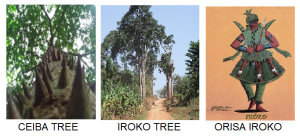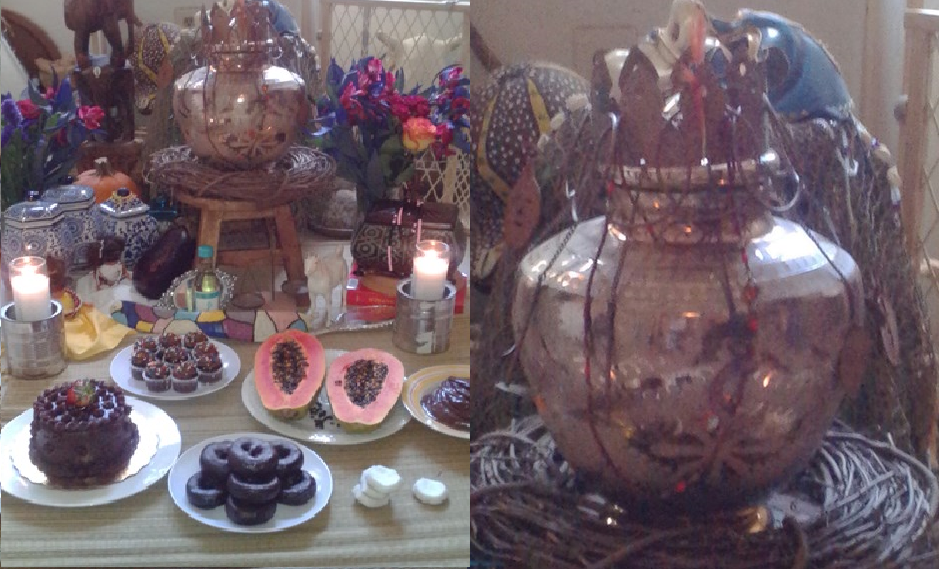ABORU ABOYE ABOSISE,
2015 AMERICAN IFA READING OF THE YEAR: ILE IKOKO ATA
This is our reading of the year. Whomever decides to read, listen and or follow is your choice. We would like to say thank you to all the priest(ess) who have made it possible to get this odu verse(s) on this side of the ocean:
ODU OTURA ‘GBE (OTURA NIKO, OTURA ORIKO)
IRE ORUN AT THE FEET OF
OBATALA GOVERNING WITH OSUN (OSHUN) ASSISTING AND WATCH ESU FOR TRICKSTERS
WITNESSING ODU OTURE OGBE IRE; IWORI’ROSUN IBI
OBI EJIFE IRE
MAFEREFUN OBATALA, OSUN, ORISA OKO, ORUNMILA, IYAMIIS AND ESU
FLAG IS WHITE ONLY at your door or outside your house over the door.
Ifa says in ODU OTURA ‘GBE:
Agbe maa gb’owun mi r’okun
Aluko maa gb’owun mi r’osa’
Odidere maa gb’owun mi re’Wo Ile, ati bee bee lo
Translation:
Agbe should boost one’s pronouncement across the ocean
Aliko should echo one’s pronouncement across the sea
Odidere should reverberated one’s pronouncement homewards
COMMENT: your neighbor’s condition may be the same as yours. We have to learn to be kind and supportive and be the foundation for each other. There will be time when we have to be the life jacket for others in serious times.
Ifa is telling us that we need to have tolerance to attract great wealth, happiness, blessings, victory and success in all our ventures.
Ifa says in ODU OTURA ‘GBE:
Aja ti mo wi loran ti o ba fe
a daja Elegbara
agbo momo ti mo wi loran ti o gba
a dagbo mole
ototo eniyan ti mo ba wi loran
ti o ba fe
ejoo e si bo ti le se ni ko mase
oun ni yoo fowo agare bomi mu
a difa fun okookan ninu irunmole
nijo ti won n lo ree ba won najaa payamora
a difa fun Ogun pelu awon irunmole
won fe lo na oja ni ile aye
won ni oja ti e lo yi
ki orisa Ogun lo toju egbaa owo ey nitori olubode
Ogun ti ro wipe tani o le da oun duro lenu ibode
aye oun torun ka bo ntori bode oja lasan lasan
ni Ogun, oni ja ole, ejemu oluwonran ,asinwin abeegun kikan afofoida ti bagba leru
ni Ogun ko ba toju owo kan kan , ko si toju egbaa owo nitori Olubode
Ogun ti ro wipe tani o le da ohun duro lenu , ni Ogun ba ko ri oja , nigbati o de enu bodeoja ni o ba olubode
eniti o je oga ibode wa ni Aja. Aja si ti mo Ogun , dara-dara wipe ko ni ipamara tabi ipayamora.
Ni Aja ba bere owo bode lowo ogun Lakaiye osin imole.
Ni Ogun ba da aja lohu wie se ko mo ohun ni abi ko ma iru eniyan ti o se ni.
Aja wa da lohun wipe , ohun ti o wa ni ile yi ju wipe, mo ma e tabi nko ma e , ohun ti o wa ni le ju mimo ara eni lo.
Ni Aja ba wi fun Ogun wipe ki o tete mu owo bode tire sile, ki wahala ma ba sele, .
Ni Ogun wa da aja lohun wipe, wahala Aja gan gan ni o ti reti, wahala aja ni o fe ri.
Ni Ogun wa so fun aja wipe ki o kuro lenu ibode nitri ibunnu oun .
Ni Ogun wa bere ija pelu aja, ni o ba be aja lori, Ogun wa ro wipe, wahala ti tan, ni ko pe, ko jina, opolopo Aja wa yo si Ogun onija ina, bi Ogun ti nbe wan lori, ni awon opolopo aja miran ba yo si.
Ni won wa bu ogun je, ni won si fa ni aso orun re ya, bee si Ogun pa won, ni o si bewo lori . Bibe ti won be awon ajaanu aja won yi lori, nse ni won poo si titi ti apa Ogun ko le ka won mo, nigbati Ogun ba awon irunmole yii, ja ni awon opolopo eniyan ati awon irunmole toku , naa oja lo, ni won duna dura, ti won si nta, ti nwon si ra, ni olukaluku won si ko ere oja wasi le, sebi awon naa gba enu ibode, won si san owo bode, nitori won le paya mora.Ipari ija ni wipe, oja ti tu, gbogbo eniya si ti na oja tan, ti won ti pada wa si ile.
Ni Ogun wa wo inu igbo nitori aso re ti o ti fa ya, o wa be mariwo ope , o wa fi bo ara re nitori ki awon eniyan ki o maa ba ma fi se yeye, ki o ma ba bi lere wipe kilode ti gbogbo aso Ogun fi faya ti o si wa ni ihoho, lati ojo naa ati igba naa ni ogun ti nse lo mariwo dipo aso, ni gbogbo se wa korin wipe, ki ni aso Ogun , mariwo laso Ogun ooo , mariwo kilaso Ogun , mariwo laso ogun mariwo.
Ati wipe aini ipaya mora lo je ki Ogun di alaini aso lara.
Ipaya mora yi de nni ifa ko wa ki a ni nile aye, ti a ba fe leke ti a ba fe bori , ti a ba fe se ohun rere ati oun mere mere in ile aye.
Ifa orunmila ni ipaya mara nitori naa ni o se je Olori ninu gbogbo Irunmole, o si wa ko wa wipe, ki a ma ni ipayamara ki a le bori ohun gbogbo Ipayamara lebo , oun ni etutu ti a fi gbe ile oko ti a fi se oko obirin , ti a fi dari oun gbogbo ki o le lo dara- dara. Ifa o ba wa fun mi ni ipayamara ki le bori iku, aisan, ofo, ofo, ese, ejo ati gbogbo ajogun orun patapa ase.
TRANSLATION:
Let my sacrifice be accepted
Ela let my ritual goes to the heaven above
the dog that refuses to heed the spiritual advise
become Elegbara’s dog
the fat ram that I warned which remained adamant and stubborn
become an Esu’s ram
the person who refuses to heed the spiritual counsel
should be left to his or her foolishness
he or she will suffer the consequence of his or her action and bring woos to his life and destruction to the destiny of his or her generation.
This divine Ifa oracle for Ogun the god of iron
and open Ifa divination to other great divinities in the cosmos
while he and other divinities were about to go to the market of tolerance
they were advised that the market they intend to go
they should keep two thousand cowries, the traditional money
Ogun the god of iron
the great fighter in battle
the great chief of ejemu oluwonran
a powerful mad man
a glitteringly sharpened sword that baffles
The old man believes, no creatures either seen or unseen, either human or ghost have the capacities to disturb him on the entrance gate of heaven or earth, not to talk of the ordinary gate of the earthily market.
Ogun decided not to keep any money. On the day of the market, Ogun the god of Iron prepared and went with other divinities to the market . On reaching the gate, he met a dog, who was the chief guard of the gate of the market.
The dog as a guard knew Ogun very well. He knew Ogun as the god of iron and also knew the evil side of Ogun as a creature without tolerance. The dog then asked Ogun the two thousand cowries money as the entrance fees of the market. Ogun responded that the dog should know he is not human, but divinities and he should not be disturbed by any man or other creature.
The dog advised Ogun to comply with the rules and regulation, that anyone who intend to go into the market must pay the entrance fees and that Ogun should not be furious. The dog advised Ogun, but the later did not heed to the advised, he Ogun had decided to force his way into the market without paying the amount. Ogun told the chief guard to quit the entrance to avoid his fury.
In the process, a fight and strife ensued. Ogun beheaded the dog, not knowing that there were more dogs in hiding to fight him immediately. After beheading, two more dogs appeared, and attacked Ogun. Ogun killed the two. As he was killing them, more dogs appeared, they torn the cloth of Ogun and also bite him.
Ogun killed more dogs than ever seen, but more dogs continue to find his way to meet and attack Ogun , until Ogun ran to the nearest bush to cover himself with palm frond . That was how Ogun covered his nudity through palm frond or palm leave from the nearest palm tree.
By the time Ogun came back with the intention of going into market to carry out his commercial activities , the market had been closed, no one was in the market. Ogun lost out in the race of physical success, and human progress because of intolerance.
Ogun the most valiant and bravest divinties forfeited the gain of the market and the reward of commercial activities. Intolerance made Ogun to lose his cloth, honor and dignity, however he was forced to be using palm frond till today , according to the popular song
What is the cloth of Ogun ? Mariwo ( palm frond)
What is the cloth of Ogun ? Mariwo is the cloth, mariwo is indeed the cloth.
Ogun become a clothless divinity because of intolerance.
ODU OTURA ‘GBE (OTURA NIKO, OTURA ORIKO) CONTINUE:
“LACK OF CONFIDENCE SUFFERING LOSSESS”
“THE EXTENSION OF IFA”
“RACE OF VARIOUS PEOPLE”
WARS AND BATTLES”
‘ALL SOLUTION CAN BE FOUND IN OUR SPIRITUALITY”
IFA SAYS be aware of two faced people – falsehood
IFA SAYS you need to have patience
IFA SAYS avoid people who are nasty, stubborn, selfish, dominant, think a lot, AND always takes opposition of what you are saying.
IFA SAYS this is the year of life and death – wear more white clothes for balance
IFA SAYS develop your spirituality and connect to your eguns/ancestors more
IFA SAYS ESU comes to remind us of the fake sellers in the world
IFA SAYS seek Oduduwa for health
IFA SAYS expect good and evil from AWOS
IFA SAYS suffering of emotional problems, throat and spine
IFA SAYS be honest with yourself when asking Ifa, Orisa and eguns for answers
IFA SAYS you should always ask the right questions when you are making life changes
IFA SAYS EBOS FOR THE ORI; NEED TO PRAY TO YOUR ORI FOR GUIDANCE
IFA SAYS expect delays
IFA SAYS to not drink alcohol
IFA SAYS destruction of families, a lot of children and new relationships
IFA SAYS ALL THIS TO PROTECT YOURSELF FROM THE OUTSIDE ENVIRONMENT WHO DOESN’T HAVE LOVE FOR YOUR LIFE
IFA SAYS you need to protect your head
IFA SAYS you need to dress well
EBO;
2 HENS TO OSHUN
1 WHITE PIGEON OR WHITE DOVE TO ORI
Continue to clean with ewe (herds) baths throughout the year

